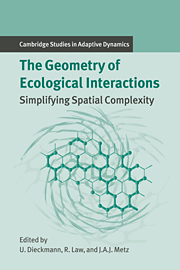Book contents
- Frontmatter
- Contents
- Contributing Authors
- 1 Introduction
- Part A Empirical and Statistical Background: A Plant Ecological Perspective
- Part B When the Mean-field Approximation Breaks Down
- Part C Simplifying Spatial Complexity: Examples
- Part D Simplifying Spatial Complexity: Techniques
- Introduction to Part D
- 18 Pair Approximations for Lattice-based Ecological Models
- 19 Pair Approximations for Different Spatial Geometries
- 20 Moment Methods for Ecological Processes in Continuous Space
- 21 Relaxation Projections and the Method of Moments
- 22 Methods for Reaction–Diffusion Models
- 23 The Dynamics of Invasion Waves
- 24 Epilogue
- References
- Index
- International Institute for Applied Systems Analysis
20 - Moment Methods for Ecological Processes in Continuous Space
Published online by Cambridge University Press: 14 January 2010
- Frontmatter
- Contents
- Contributing Authors
- 1 Introduction
- Part A Empirical and Statistical Background: A Plant Ecological Perspective
- Part B When the Mean-field Approximation Breaks Down
- Part C Simplifying Spatial Complexity: Examples
- Part D Simplifying Spatial Complexity: Techniques
- Introduction to Part D
- 18 Pair Approximations for Lattice-based Ecological Models
- 19 Pair Approximations for Different Spatial Geometries
- 20 Moment Methods for Ecological Processes in Continuous Space
- 21 Relaxation Projections and the Method of Moments
- 22 Methods for Reaction–Diffusion Models
- 23 The Dynamics of Invasion Waves
- 24 Epilogue
- References
- Index
- International Institute for Applied Systems Analysis
Summary
Introduction
Spatial dynamics of populations have long been of interest to ecologists (Skellam 1951; Levin and Paine 1974; Andow et al. 1990), but recent advances in data collection and in computational power have put these concepts within the reach of many ecologists for the first time. Computational models (Wilson et al. 1993, 1995b; McCauley et al. 1993; Pacala and Deutschman 1995) suggest important and previously unexplored effects of space and discrete individuals on population dynamics. Analytic approaches that capture these effects are emerging, building on methods developed in other contexts. This chapter presents a general method for deriving approximate equations for spatial dynamics in continuous space and time that has advantages over classical and many modern approaches.
We are interested in spatial pattern formation in plant communities and in the effects of pattern on plant competition. Our goal is to find general methods for exploring this problem that are
analytically tractable, so that we can gain insight into qualitative behaviors of the system and analyze how they depend on the parameters;
sufficiently general, so that some of the same tools can be applied to answer a range of different questions about spatial dynamics in ecology; and
close enough to the characteristics of real populations that we can eventually fit the models to field data on individual behavior.
We focus on spatial point processes (Diggle 1983; Gandhi et al. 1998), continuous-time dynamical systems for discrete individuals interacting in a continuous habitat.
Information
- Type
- Chapter
- Information
- The Geometry of Ecological InteractionsSimplifying Spatial Complexity, pp. 388 - 411Publisher: Cambridge University PressPrint publication year: 2000
Accessibility standard: Unknown
Why this information is here
This section outlines the accessibility features of this content - including support for screen readers, full keyboard navigation and high-contrast display options. This may not be relevant for you.Accessibility Information
- 25
- Cited by
